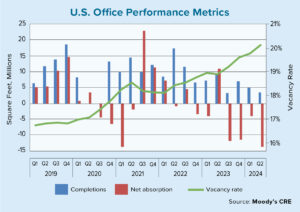The commercial mortgage broker’s primary job is to form relationships with multiple lenders so that they can accommodate various real estate lending scenarios for their clients. Lender preferences and tolerance for risk changes over time, however, so it is imperative for the mortgage broker to stay abreast of the lender’s current policies.
The only way to do this is to have a basic understanding of how the lender evaluates the riskiness of borrowers and loan proposals. Accordingly, you must understand the concept of leverage. In finance, leverage is any technique involving the use of additional debt rather than equity in the purchase of new assets, with the anticipation that the after-tax profit for an investor will be greatly enhanced.
The greater the ratio of debt to equity in the financing mix, the greater the leverage. Leverage is powerful, but it has the potential to be deadly. A highly leveraged borrower is more susceptible to business or market downturns than those with lower debt-to-equity positions. Be assured that lenders are paying attention to a borrower’s leverage levels when evaluating a new commercial mortgage request in today’s market.
Capital stack
A company’s capital structure is primarily comprised of two types of financing: long-term debt and the owner’s equity. This mix will vary depending on the proposed transaction. There is no best or perfect ratio.
Too much debt, however, hurts earnings by creating a high-interest expense. Lenders may become nervous about the potential for loan default if they suspect that a company is excessively leveraged. This makes it more difficult to secure additional debt and may cause the borrower’s personal credit rating to drop, making the cost of additional debt even higher.
If it’s effectively managed, however, the addition of debt can be a much more attractive option than taking on an equity partner. Debt is expensive but less so than equity capital. With debt capital, the interest rate is known, agreed upon and restricted to a defined period of time. Equity, on the other hand, is considerably more expensive than debt and does not have a maturity date. The equity investor will demand some type of dividend during the life span of their investment in the company.
An investor also will expect a higher rate of return when an investment carries more risk. Generally, the equity investor will demand higher returns for investing in a small, privately held company with limited resources, marginal liquidity, constrained market share, and a single product or service as its primary source of income.
Power of leverage
Investors use leverage to increase their purchase power in the marketplace. Although leverage is a great concept on paper, it also is a fair-weather friend. The debt magnifies the return on investment when revenues are plentiful, but it also amplifies losses when revenues falter.
Say, for example, that an investor finances the purchase of an $800,000 property with $600,000 in debt and $200,000 in equity. If property gains 10% in value, or $80,000, in the first year following the purchase, the return on investment is 40% ($80,000 divided by $200,000). Conversely, if the same property declines in value by 10%, the investor will have a corresponding loss of 40%. The point is that the debt has facilitated these massive profits and losses.
At the same time, it is often unclear to an investor — or a lender, for that matter — what the ideal leverage ratio should be. Lenders require a lot of information when considering the appropriate leverage. Say that a company has equity of $4 million and is carrying a total debt of $25 million. The debt-to-equity ratio is 6.25.
Is this good, bad or just right? The fact is, without a lot more information, you can’t make an intelligent decision. These numbers don’t tell us what the company’s historical debt-to-equity ratio has been, nor do we know the leverage levels of similar companies within the same industry. One ratio by itself is meaningless because it provides little insight about a company’s performance and doesn’t tell enough of the story to make a good decision.
Complex analysis
When interpreting the debt-to-equity ratio, the industry itself is a critical factor in the evaluation, and different industries have various capital requirements. A relatively high debt-to-equity ratio may be the norm in one industry, while a low ratio may be common for another.
The appropriate leverage depends on the project’s potential profitability; the nature and magnitude of its risks; the strength of the collateral; and the creditworthiness and experience of the borrowers. There are numerous shortcomings tied to the use of excessive leverage. Asset values may rapidly decline and financial risk may increase due to higher leverage. Poorly managed companies also are less likely to support high leverage.
A high debt-to-equity ratio frequently indicates that a company is optimistic and is willing to finance its expansion with greater levels of debt. This decision, however, may ultimately destabilize the company. The company is taking on extra expenses. If the debt is excessive and revenues are unstable, the company will be challenged to service the debt. This increases the risk of default and, in extreme cases, can lead to insolvency.
As previously discussed, there is no single perfect leverage level. As the variables and assumptions change, the appropriate ratio also will change. A well-constructed financial model allows management to make certain assumptions about optimal leverage ratios, but it is important to remember that these are only assumptions. The final results have yet to unfold and therein lies the risk of leverage.
In today’s commercial real estate market, there is a lot of capital ready to deploy and many lenders are willing to be aggressive. Just because your borrower has the opportunity to fund a transaction at a 90% debt level, however, does not mean that this the best financial decision. Leverage always comes with greater operational risk. ●
Author
-
Garry Barnes is managing director of PW Partners Consultancy, headquartered in Salt Lake City, and is a freelance writer. He is a former president and CEO of banks in Arizona, California and Utah. He has taught at the university level, and is a frequent writer and lecturer on banking, finance and real estate matters. Barnes has served on the U.S. Small Business Administration’s National Advisory Council and received the SBA Arizona Financial Services Advocate of the Year award.
View all posts






